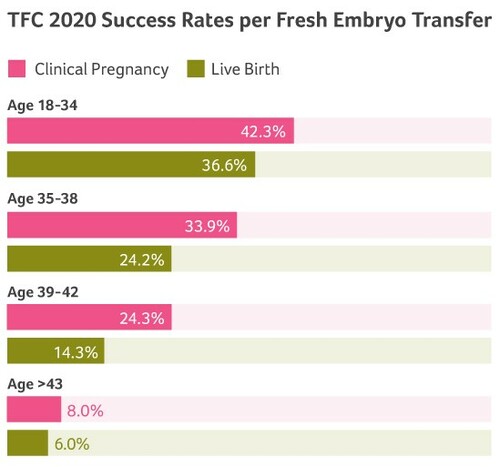IVF Success Rates in NSW
How do you measure IVF success?
IVF success rates are sometimes quoted per complete IVF cycle. A complete IVF cycle may involve the transfer of multiple embryos collected from one egg collection. Success rates reported this way will appear higher than success rates reported per embryo transfer.
At The Fertility Centre, we measure IVF success rates as clinical pregnancies (a pregnancy confirmed by a blood test and ultrasound, usually at around 6-8 weeks) per embryo transfer. Unfortunately not every pregnancy will carry to a live birth, so live births are also quoted per embryo transfer.
We report this way to give you the most realistic understanding of your chance of success following each individual embryo transfer.
It is also important to be aware that not every treatment cycle results in an embryo transfer, because sometimes there are no eggs collected or after eggs have been collected no embryos develop so an embryo transfer cannot take place.
To understand IVF success rates it is important to understand what part of the IVF treatment cycle a particular statistic is measuring before you compare them.
There are also other factors that need to be understood before you begin to compare IVF success rates. These include:
- A woman’s age. This is the most important factor determining IVF success rates, so you want to make sure you are comparing rates for woman of the same age.
- Whether the clinic transfers more than one embryo with each transfer. More embryos per transfer may make success rates appear higher. At The Fertility Centre we have a single embryo transfer policy to reduce the risk of multiple births, low birth weight and premature births.
- Whether the success rates data includes techniques such as ICSI and whether it includes frozen embryo transfers or only fresh embryo transfers.
If you are undergoing IVF treatment we know that IVF success rates are important to you, and the below section will help you understand how to interpret IVF statistics.
The Fertility Centre in New South Wales was established in February 2013 and we’re proud of the success rates we are achieving for our patients.
The Fertility Centre’s simplified IVF treatment model is only suitable for a select group of patients, with straightforward fertility issues, who meet specific criteria. We are not able to assist patients with very complex fertility issues; that require genetic testing or the use of donor eggs/sperm. These patients will be referred to our Sydney partner clinic IVFAustralia for treatment.
The following graph shows the proportion of fresh embryo transfers in patients using their own eggs that resulted in a clinical pregnancy and a live birth in 2020.
The success rates shown not include any additional frozen embryo transfers that may have eventuated from that IVF treatment cycle.
The success rates shown include embryos where the eggs have been fertilised by IVF and those which have been fertilised by ICSI. No preimplantation genetic testing is carried out at The Fertility Centre.

The following graph shows the proportion of frozen embryo transfers using their own eggs that resulted in a clinical pregnancy and live birth in 2020.
The success rates shown include embryos where the eggs have been fertilised by IVF and those which have been fertilised by ICSI. Preiimplantation genetic testing is not performed at TFC.

For further information on interpreting success rates you can refer to the FSA guide "Interpreting Pregnancy Rates: a consumer guide".
Want to know more about IVF success rates?
There are many factors that contribute to your chance of a successful pregnancy through IVF. During your initial consultation at The Fertility Centre with one of our fertility specialists your individual chance of conception and a baby will be discussed based on your personal circumstances.
To make an appointment with an experienced fertility specialist at The Fertility Centre, simply call 1800 842 862 or request an appointment online.